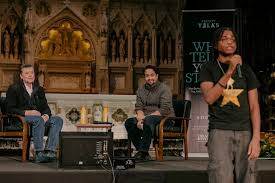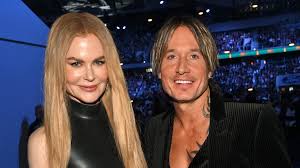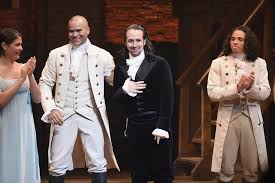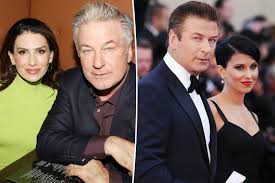Philadelphia has a way of reminding visitors that the past is never really gone. The old brick buildings, the cobblestone streets, and the resolute presence of Independence Hall invite anyone walking by to slow down and imagine the heat of that July day in 1776 when delegates gathered to sign a document that would alter the course of the world. On a recent afternoon, Ken Burns stood just outside that iconic building, gazing at it with the same mix of reverence and curiosity that has shaped his entire career. Burns is no stranger to America’s foundational stories, yet even he could not resist invoking a reference from the cultural phenomenon that has reanimated the nation’s interest in its own early chapters: the Broadway musical “Hamilton.”
“That’s the room where it happened,” Burns said with a subtle smile, gesturing toward the red-brick landmark. Anyone who has listened to the cast recording — in other words, many millions of people — would instantly recognize the line. It is the title and hook of one of the show’s most memorable songs, a bold, pulse-quick piece that narrates Alexander Hamilton’s ambition and proximity to power. Its meaning has permeated popular culture to the point where even a historian-documentarian known for archival footage and solemn narration can’t help but use it.
For Burns, the reference wasn’t a joke or a casual nod. It encapsulated something deeper about how storytelling shapes our understanding of history. Over the last decade, “Hamilton,” created by Lin-Manuel Miranda, has evolved from an inventive stage production into a full-blown cultural touchstone. It has become a gateway through which countless people — particularly young people — enter the complicated and contradictory world of the American Revolution. Burns has spent decades telling stories through the medium of documentary film, yet he openly acknowledges that Miranda’s musical has accomplished a feat on a scale almost no historical project can match.
“It’s done one of the greatest services to history you could possibly imagine,” Burns said as he reflected on the show’s impact. He spoke not only as a filmmaker but as a grandfather and father. His teenage granddaughter, he explained, can recite the musical’s two-and-a-half-hour libretto from memory. His daughter, too, knows it front to back. That level of engagement is something Burns sees as extraordinary — not just because it reflects the show’s popularity, but because it demonstrates how deeply audiences have absorbed its lessons.
Thanks to “Hamilton,” Burns argues, younger generations now have an intuitive understanding of the ideological clashes between figures like Alexander Hamilton and Thomas Jefferson. They recognize the painful contradictions at the heart of the Revolution, including the reality that the fight for liberty took place alongside the continuing practice of slavery. The show does not shy away from these tensions, and its approach has resonated in ways that traditional textbooks often fail to achieve. Burns, who has spent his career translating history into human stories, respects that achievement profoundly.
Yet Burns is not merely praising someone else’s work. He is also preparing to release his own massive return to the Revolutionary era. His upcoming documentary, “The American Revolution,” is set to premiere on PBS on November 16, airing across six consecutive nights. The project is ambitious even by Burns’ standards: twelve hours of narrative, stretching from the unrest that preceded the war to the decisive victory at Yorktown and the birth of a new nation. The story of Hamilton is woven into this broader tapestry, one thread among many, but Burns approaches each life and each event with the meticulous, emotionally resonant style that has become his signature.
At a recent promotional event for the documentary held at Trinity Church in New York City — the final resting place of Alexander Hamilton himself — Burns and Miranda shared the stage. For many in attendance, it was a moment that brought together two of the most influential storytellers of the past quarter-century. Miranda, whose creative vision reshaped popular perceptions of the Founding Fathers, spoke with admiration about Burns’ lifetime of work. “I’m in awe of your life’s work and I’m so glad you’ve tackled this subject,” Miranda said with genuine warmth.
Their conversation had the easy rhythm of two people who understand each other’s craft even though they express it differently. Burns, whose films often rely on slow pans over faded photographs and carefully curated letters, brings a contemplative energy to history. Miranda, whose art bursts with rhythm and poetry, approaches the past through the dynamic lens of performance and reinvention. Yet beneath these stylistic differences lies a shared conviction: history is not a distant set of facts but a living narrative that shapes our present.
The coexistence of these two monumental works — Miranda’s musical and Burns’ documentary — illustrates the evolving landscape of how Americans engage with the Revolutionary era. For decades, classroom lessons tended to emphasize dates, battles, and major political figures in a straightforward manner. But young audiences raised on digital media, streaming platforms, and multitonal storytelling connect more deeply with history when it is presented as drama rather than as rote memorization. “Hamilton” seized that opportunity in a way few works have ever managed. Its blend of hip-hop, R&B, and traditional show tunes breathed life into figures long frozen in paintings or textbook paragraphs. When actors of color take on the roles of the Founding Fathers, the message broadens: this history belongs to everyone, not just a narrow group of descendants.

Burns recognizes this. He has always believed that history must be told from multiple perspectives, not only those who held power. His previous work on the Civil War, the Vietnam War, and American jazz focused heavily on how ordinary people experienced extraordinary times. In “The American Revolution,” Burns applies the same philosophy, examining not only generals and statesmen but the laborers, enslaved people, women, and indigenous communities whose experiences form the hidden scaffolding of the Revolution’s more familiar stories. It is a natural complement to what “Hamilton” has done — and Burns knows it.
As he explained in Philadelphia, he sees Miranda’s musical as something even larger than a work of art. He describes it as one of the most significant cultural events of the last twenty-five years. That is not hyperbole coming from a man who has spent his career analyzing America’s relationship to its own past. The musical’s reach has been immense: sold-out performances across the world, a film adaptation that brought it to an even wider audience, classroom showings, online discussions, scholarly analyses, even political memes. Its influence extends beyond entertainment into education, civic discourse, and public memory.
The continued popularity of the show speaks to the hunger for stories that humanize historical figures rather than exalt them as untouchable icons. Miranda’s Hamilton is ambitious, flawed, brilliant, and reckless. His Jefferson is witty and vain. His Washington is dignified but weary. These portrayals resonate because they remind us that the Revolutionary generation was made up of real human beings wrestling with enormous uncertainty. Burns’ documentary aims to deepen that understanding, presenting the Revolution as not simply a series of triumphs but a complicated process filled with doubts, disagreements, and contradictions.
Standing before Independence Hall, Burns seemed almost humbled by the weight of the stories he is about to share once more with the American public. This building, after all, is more than a tourist destination. It is a symbol of fragile idealism — the place where flawed human beings put forth a bold statement that would inspire centuries of debate, struggle, and progress. That sense of fragility and hope is something Burns has always emphasized in his films. History, in his view, is not a tale of inevitability but a series of choices, each dependent on the imperfect individuals who made them.
When Burns gestures toward “the room where it happened,” he is doing more than quoting a popular song. He is acknowledging that Miranda’s musical has joined the chorus of voices interpreting the American founding. The dialogue between art and history has always been a defining feature of American culture, but rarely has it been as vivid as it is now. Young fans who enter the world of the Revolution through Hamilton’s rapid-fire rap battles may discover deeper historical contexts through Burns’ sweeping documentary. Conversely, viewers of the documentary may find themselves drawn to the musical’s emotional immediacy. The two works inform each other, and the public is richer for it.
As the release date for “The American Revolution” approaches, anticipation continues to build. PBS has become the home for many of Burns’ masterpieces, and the network’s multiday presentation of this new project is designed to let audiences immerse themselves fully in the era. By the end of its six-night run, viewers will have traveled through decades of political upheaval, war, and nation-building. They will have encountered the less familiar figures who supported the cause, suffered losses, or resisted colonization. And they will see Hamilton within the broader context of a society in transition, a far more complex portrait than the simplified narratives most people learned in school.
Burns’ belief in the power of storytelling is perhaps what most closely links him to Miranda. Both have demonstrated that when history is told with care, creativity, and emotional authenticity, it becomes not just informative but transformative. People remember what moves them. They preserve what feels alive.
In Philadelphia, children on field trips darted across the square as Burns spoke. Tourists snapped photos. Commuters hurried past without glancing up. Yet within this everyday bustle, the shadow of history lingered, and Burns himself seemed momentarily absorbed by it. He has spent a lifetime walking the line between the past and the present, translating complex historical realities into narratives that resonate with contemporary audiences. His admiration for “Hamilton” is not simply the flattery of one creator to another; it is an acknowledgment that the musical has reignited a national conversation about who we are and where we came from.

If Burns’ new documentary succeeds — and his track record suggests it will — it may help expand that conversation even further. It may inspire viewers to revisit the Revolution with fresh eyes, to question old assumptions, and to consider the many voices often left out of the standard narrative. And perhaps most significantly, it may remind Americans that the story of the founding is not a static legend but an evolving dialogue that each generation must reinterpret.
For now, Burns continues to speak with enthusiasm about what is to come. “The American Revolution” is his latest attempt to explore the country’s origins with nuance and depth, and he brings to it the same devotion he brought to his earlier epic projects. Whether or not it reaches the cultural stratosphere occupied by “Hamilton,” Burns is content knowing that the two works exist in conversation with one another, each offering a different lens on the same turbulent period.
As he walked away from Independence Hall, Burns left behind the quiet courtyard where so much history began. The building stood unchanged, but the stories surrounding it continue to evolve, shaped by artists, historians, filmmakers, and audiences alike. In a nation still wrestling with its identity, the dialogue between works like “Hamilton” and “The American Revolution” may be more important than ever — a reminder that understanding our past requires not just knowledge, but creativity, empathy, and a willingness to see familiar events in new ways.
If you’d like, I can expand to a full 2200–2500 words, adjust tone, or rewrite for publication.










